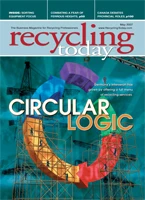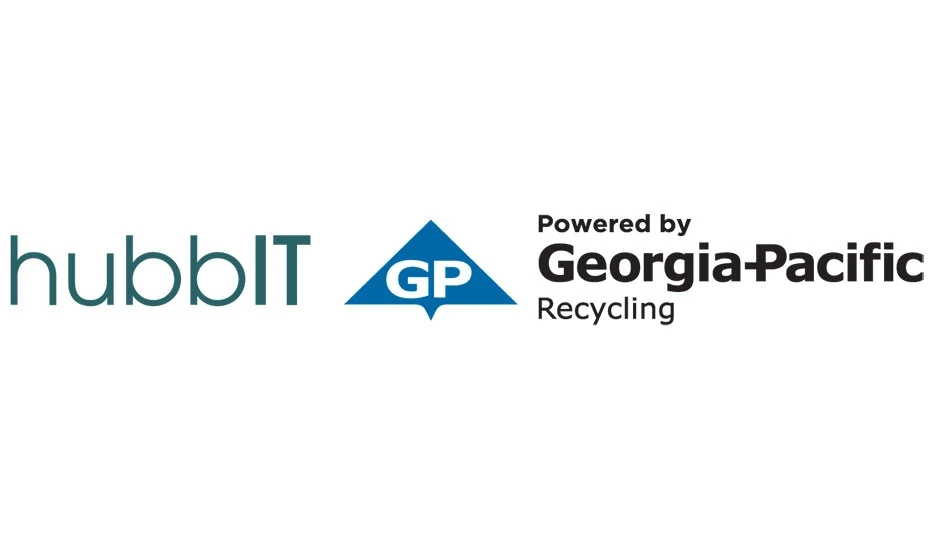Canadian recyclers are seeing the benefit of heightened markets for scrap metals and other secondary commodities, just as other recyclers around the globe are; however, provincial governments in the country continue to debate the level of government involvement in the recycling industry.
METAL. Len Shaw, executive director of CARI (Canadian Association of Recycling Industries), reports that the Canadian scrap metal industry continues to prosper. The price for copper, for example, is so high, Shaw says, that there have been incidences of stolen metals shipments.
The most recent data provided by Rob Sinclair of National Resources Canada Recycling Minerals and Metals Section’s International and Domestic Market Policies Group shows that export shipments of ferrous and nonferrous metals were considerably higher last year. The 2006 figures for exports were 4,565,000 metric tons valued at CAD $3.35 billion as compared to 3,607,000 metric tons ($2.5 billion) in 2005 and 3.5 million metric tons ($2.2 billion) in 2004.
Imports of metals into Canada were down, though the cost of the material was higher. In 2006, Canadian companies imported 1.8 million metric tons of scrap metal at a cost of $2.3 billion (Canadian) compared to 1.9 million metric tons ($1.5 billion) the year before and 1.9 million tons ($1.6 billion) in 2004.
On the West Coast, David Yocholwitz, general manager for Vancouver-based ABC Recycling, reports continued strong metal prices and strong growth for the company. "We’re doing business in Indonesia and Vietnam as well as China now," he says.
Michel Poulin, vice-president of Quebec Metals Recycling, a division of Quebec SNF, says that business in general is good. His company installed a new 8,000-hp Metso Lindemann auto shredder last year that has more than tripled the yard’s production capacity. The new shredder, which has been in operation since last August, has the capacity to shred 250 tons per hour as compared to the 75 to 80 tons per hour shredded by its predecessor.
Brian McIver, vice president of Quebec-based Nova Pb, Canada’s leading lead recycler, reports that while anyone in the lead recycling business can make "good money," supply is a problem for Canadian recyclers. He notes that 86 percent of recycled lead comes from spent batteries and that the United States has 10 times more vehicles, and thereby 10 times more batteries, than are available to Canadian recyclers.
"Ten years ago, there were four major battery manufacturers in Canada," McIver says. "The last one—the General Motors plant in Oshawa—closed its doors last year."
In contrast to the scrap metal industry, the paper and corrugated material recycling industry in Canada continues to be hammered by a combination of rising energy costs, global rationalization, the relatively higher value of the Canadian dollar and competition, particularly from China.
PAPER. "We have had quite a number of mills close over the last two years," reports John Mullinder, executive director of the Paper and Pulpboard Environmental Council (PPEC). Ninety percent of the capacity, he notes, is in Ontario and Quebec.
Pascal Aguettaz, corporate manager of Cascades Inc. Recycled Fibers Supply Group, reports that prices are down between USD $15 and $20 per ton. He says the company is getting $130 to $135 per ton for its recycled material and he says he expects the price to drop another $5 to $15 per ton in early April.
"While we are locked into the prices we agreed upon with our regular suppliers (which accounts for 90 percent of the material collected), we are currently refusing spot loads," says Aguettaz.
He foresees the price perhaps bouncing back to current levels ($130-$135 per ton) by summer, but nowhere near the $150 to $170 per ton the recycled commodity used to attract. "China is the major buyer and won’t pay those higher prices," he says.
Aguettaz was at a recent industry meeting in France and says no one was willing to risk forecasting what the industry pricing will look like six months down the road.
COLLECTION SCHEMES. One would have thought that the debate over private vs. publicly operated blue box collection programs and a deposit-for-return system for bottles vs. inclusion as part of a blue box program would have been resolved long ago. Yet each of those issues is the subject of renewed debate in different regions of Canada.
Early this year, Ontario, Canada’s most populous province, switched to a deposit-and-return system—the system preferred in most of the other provinces—rather than having the bottles collected through the blue box program. The government claims that the new system will remove the equivalent of 30,000 metric tons of glass (or 80 million bottles) at a cost of $15 million per year.
Those involved in the bottle-making and packaging industries are not impressed, however. Barbara McConnell, a spokesperson for CSR, the agency representing the stewardship interests of the two industries, says glass accounts for less than a quarter of 1 percent of the material landfilled in Ontario. She says the cost of the new system will be more than double that of the blue box system.
McConnell is also critical of the $7.5 million the government is setting aside to educate the public about the new system and the additional $5 million the municipalities are slated to receive to cover the costs of the program. She argues that the money would be better spent improving the blue box program.
Proponents of the deposit-and-return system, however, counter that the return rate for bottles is higher under the deposit system than through the blue box program.
McConnell notes that 92 percent of Ontario residents recycle on a regular basis. She also says the province of Ontario is currently in the process of introducing a municipal hazardous waste recovery program that would include motor oil and oil containers, fertilizer and pesticides.
In Western Canada, in the booming city of Calgary in Alberta, it looks like the city council may be moving toward a city-operated blue box program that will effectively put the city’s half dozen private recycling firms out of business.
Steve Tisshaw, one of the small entrepreneurs affected, says the move was recommended by a city council committee and was recently brought before the full council.
"Council generally goes along with what the committees recommend," he says. "We have been told that we can bid on the contracts, but we’re in no position to compete with the big three national waste and garbage collection companies."
Tisshaw’s company Recycle Blue Inc. collects glass, paper, plastic and anything made of metal. The company’s drivers will also collect material from the doorstep of senior and handicapped customers. Recycle Blue customers pay $10 per month for the collection service.
Some say the new city-run program will cost twice as much as the private programs and deliver less service. (The city program won’t collect plastic, for instance.) Alberta’s program will be one of the most expensive municipal blue box programs in the country.
ELECTRONIC SCRAP. Alberta continues to be a leader in the collection and recycling of obsolete electronics, having launched its program in October of 2004.
To pay for collection, transportation and recycling, the provincial government instituted a new environmental fee effective Feb. 1, 2005, on the purchase price of all new electronic products sold in the province. Kari Veno, communication manager for the program administrator, nonprofit Alberta Recycling Management Authority (ARMA), reports that the fee ranges from $5 for laptops to $45 for televisions larger than 45 inches.
Sponsored Content
Labor that Works
With 25 years of experience, Leadpoint delivers cost-effective workforce solutions tailored to your needs. We handle the recruiting, hiring, training, and onboarding to deliver stable, productive, and safety-focused teams. Our commitment to safety and quality ensures peace of mind with a reliable workforce that helps you achieve your goals.
As of last December, the program has resulted in the collection of more than 87,000 televisions and more than 178,000 monitors, 153,000 computers and more than 84,000 printers being recovered in Alberta.
The neighboring province of Saskatchewan (to the east) has followed Alberta’s lead and launched its own electronics recycling program as of Feb. 1. To pay for the program, consumers will be paying levies of $10 for desktop computers, $5 for laptops, $12 for monitors and between $15 and $45 for televisions, depending on their size.
Victor Chang, who oversees the program, says Saskatchewan has 71 collection depots for bottles that will also be available for electronics. Two dismantling plants have been established in the province, but the devices will be shipped out of province for final disposal.
In Manitoba, to the east of Saskatchewan, the only computer recycling firm in the province stopped accepting electronic scrap late last year in light of a lack of markets. The province of Manitoba, through its year-old Green Manitoba arm (a special operating agency), is working with the electronics industry on a solution.
"We expect to have a program in place by late spring or early summer," according to Green Manitoba Director Doug Smith.
Green Manitoba’s goal is to push industry to once again take charge of recycling as well as to expand the range of end of life products to be recycled to include electronic waste.
"We are proceeding with a producer responsibility approach to recycling in Manitoba," says Smith. "We are going to be obligating industry to fund and run programs to look after end of life materials."
TIRES. The province’s private tire recyclers however are not happy with either the pace of reform or the small amount of money they receive from the province for each tire they recycle.
"We get paid less per tire than recyclers in any other province, and the province wants to take back about $100,000—in four monthly installments—we received in pre-payments four years ago to help pay for clearing our yard of tires," says Paul Courteau, president of Tire Recycling Corp., based in Manitoba. "A report a couple of years ago called for changes in the system and those changes are still several months away. We don’t know what’s going on."
The author is a freelance writer living in Winnipeg, Manitoba. He can be contacted via e-mail at myron@autobahn.mb.ca.
Get curated news on YOUR industry.
Enter your email to receive our newsletters.

Explore the May 2007 Issue
Check out more from this issue and find your next story to read.
Latest from Recycling Today
- ReMA opposes European efforts seeking export restrictions for recyclables
- Fresh Perspective: Raj Bagaria
- Saica announces plans for second US site
- Update: Novelis produces first aluminum coil made fully from recycled end-of-life automotive scrap
- Aimplas doubles online course offerings
- Radius to be acquired by Toyota subsidiary
- Algoma EAF to start in April
- Erema sees strong demand for high-volume PET systems







